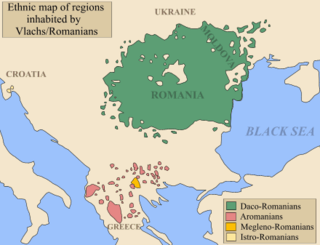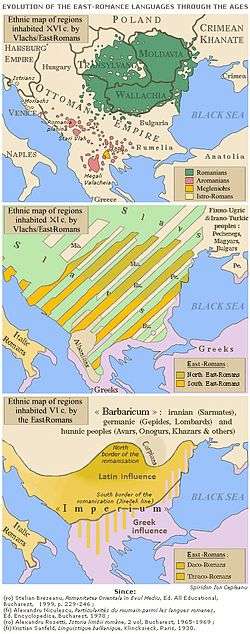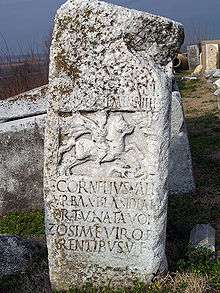Eastern Romance languages
| Eastern Romance | |
|---|---|
| Geographic distribution | Balkans and part of Eastern Europe |
| Linguistic classification | Indo-European |
| Subdivisions | |
 Map of Eastern Europe with regions currently significantly inhabited by Romanians/Vlachs highlighted | |


The Eastern Romance languages are a group of Romance languages that developed in Eastern Europe (specifically in the Balkans) from the local variant of Vulgar Latin. Today, the group consists of Romanian, Aromanian and two other related minor languages Megleno-Romanian and Istro-Romanian.
Being part of the same family, they share many features with each other. Similarities include morphology and syntax, as well as large commonalities in vocabulary. However, alongside their similarities, there are also considerable dissimilarities that make it difficult for their speakers to understand each other.
Some languages of Italo-Dalmatian are sometimes included in the Eastern Romance. In fact, when Italian is classified as Western Romance, Dalmatian generally remains in Eastern. However, this article is concerned only with Eastern Romance in the narrow sense, without Italian and Dalmatian.
The Eastern Romance languages are also known as Vlach languages and their speakers, in addition to their specific, national name, are also named collectively as Vlach people.
Origin theories and history
According to the generally accepted theory regarding their origin, the Eastern Romance languages, are considered to be a evolution of the Vulgar-Latin, spoken in the Balkan area during the domination of the Roman Empire. The Vulgar-Latin, in its turn, is considered to be a mixture of the ancient, local languages: Illyrian, Thracian, Dacian, and the official Latin (the language of Rome). It formed for centuries a language continuum, spread across the Balkans. After the arrival of Slavic people in the region ( V-VII cent.), many of the indigenous people were assimilated while others were obliged to move and disperse, losing in that way the homogeneity and the previous contacts between them. As a result, the formation of the four languages, that nowadays constitute the Eastern branch of the Romance Languages family, took place.
- North-Danubian
- Romanian, including the South-Danubian Vlach language in Serbia and Bulgaria; Romanian is often called Daco-Romanian to distinguish it from the South-Danubian languages
- South-Danubian languages
This classification is contested by some Romanian scholars, who classify Istro-Romanian with Daco-Romanian, as a North-Danubian language, and estimate that Megleno-Romanian shows mixed features, being intermediate between the Daco-Romanian and Aromanian.
As another consequence of the foreign invasions, the Vulgar-Latin was influenced at various degrees by Slavic and other languages. The Slavic invasion was more massive in the central part of the domain, from where originated the actual speakers of Aromanian, Megleno-Romanian and Istro-Romanian. Here and there, and especially in this central part, the Vulgar-Latin became insular and eventually disappeared. Notable examples of populations that once spoke Eastern Romance languages, entirely slavized today, are:
- The Vlachs from the Balkans, founders of the Vlach-Bulgarian Empire
- The North-Carpathian ethno-cultural groups of Hutsuls, Lemkos, Boykos, Gorals and Moravian Wallachians.
This process of assimilation continues until today, the South-Danubian languages and some varieties of the Daco-Romanian spoken outside Romania being highly endangered.
Common features with Western Romance languages
| Eastern Romance languages |
|---|
|
Vulgar Latin language Substratum Thraco-Roman culture |
| Romanian |
|
| Aromanian |
| Megleno-Romanian |
| Istro-Romanian |
They share a few sound changes with the western Romance languages: some with Italian, such as [kl] > [kj] (Lat. clarus > Rom. chiar, Ital. chiaro) and also a few with Dalmatian, such as [gn] > [mn] (Lat. cognatus > Rom. cumnat, Dalm. comnut). However, most of them are original, see: Latin to Romanian sound changes.
Differences from Western Romance languages
The languages that are part of this group have some features that differentiate them from the western Romance languages, notable being the grammatical features shared within the Balkan language area as well as some semantic peculiarities, such as lume ("world") being derived from Latin lumen ("light"), inimă ("heart") being derived from Latin anima ("soul"), etc.
The languages also share a similar Paleo-Balkanic substrate.
An asymmetrical merger of Latin vowels, with /i/ merging with /ē/ but /u/ merging with /ū/, sets off Eastern Romance from the symmetrical merger of /u/ with /ō/ and /o/ found in Western Romance. However, while this persists today in only a few isolated dialects in western Basilicata, such as Castelmezzano dialect, as well as Dalmatian and the Romanian languages, there is evidence that it once occurred throughout southern Italy.[1]
Samples of Eastern Romance languages
Eastern Romance languages:
(note: the lexicon used below is not universally recognized):
| Istro-Romanian | Aromanian | Megleno-Romanian | Romanian | Italian | English |
|---|---|---|---|---|---|
| pićor | cicior | picior | picior | gamba | leg |
| kľeptu | cheptu | kľeptu | piept | petto | chest |
| bire | ghine | bini | bine | bene | well, good |
| bľerå | azghirari | zber | zbiera | ruggire | to roar |
| fiľu | hilj | iľu | fiu | figlio | son |
| fiľa | hilje | iľe | fiică | figlia | daughter |
| ficåt | hicat | ficat | fegato | liver | |
| fi | hire | ire | fi | essere | to be |
| fľer | heru | ieru | fier | ferro | iron |
| vițelu | yitsãl | vițål | vițel | vitello | calf |
| (g)ľerm | iermu | ghiarmi | vierme | verme | worm |
| viu | yiu | ghiu | viu | vivo | alive |
| vipt | yiptu | vipt | cibo (vitto) | food, grain | |
| mľe(lu) | njel | m'iel | miel | agnello | lamb |
| mľåre | njare | m'ari | miere | miele | honey |
References
- ↑ Michele Loporcaro, "Phonological Processes", in Maiden et al., 2011, The Cambridge History of the Romance Languages: Volume 1, Structures